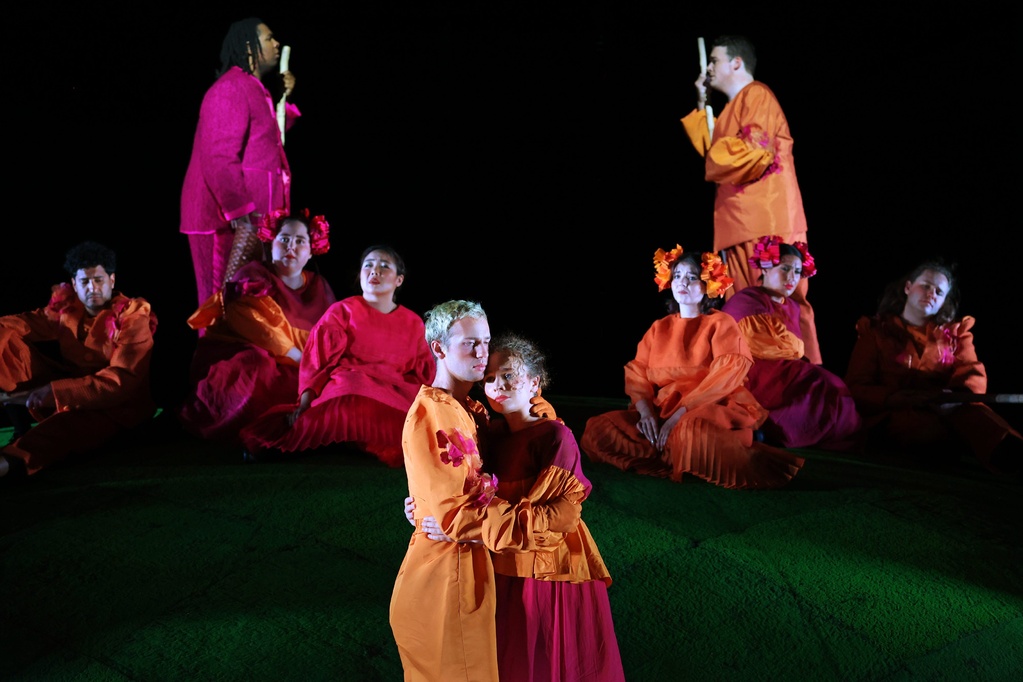The new production of “Orfeo” by the Santa Fe Opera, which hosts performances at its open-air Crosby Theatre home in the capital city of New Mexico, requires that the key characters wear wireless microphone systems, a need being met with the deployment of Lectrosonics SSM belt pack transmitters and numerous channels of Venue2 receivers.
The production, directed by Yuval Sharon with music by Claudio Monteverdi and a world premiere orchestration by Nico Muhly, is a re-imagining of one of the oldest known operatic works. The artistic choices include the use of effects-processing on individual voices as well as mixing them spatially into the specially built multichannel surround system, necessitating the need for wireless systems.
Although opera traditionally is done 100 percent acoustically, the artistic directions that Sharon took for “Orfeo” required very close miking of the non-chorus performers so that their voices could be cleanly processed. Area mics would not sufficiently isolate the individual voices from each other and from ambient sound. Therefore, sound designer Mark Grey opted to use Lectrosonics wireless systems, having employed them in recent years with the Santa Fe Opera in staging “Doctor Atomic” by John Adams and “The Lord of Cries” by John Corigliano.
Grey explains, “In Act II when the characters go down into Hades, Yuval wanted the sound world to radically change. I got into the Crosby Theater and started experimenting with the processing, like reverberation coming from the surround sound, and key roles sung or spoken from offstage.” He supplemented the theater’s four main PA loudspeakers with 10 more to create the surround system that would give spatial effects to the otherworldly reverberant vocal fields.
Next he allotted 14 Lectrosonics wireless channels this way: “Thirteen channels are on characters who are onstage and sometimes offstage. The fourteenth is dedicated to a character who is only offstage. We also have wired microphones offstage. We’re using DPA 4061 mics on the SSM belt packs.”
Abbey Nettleton, the opera’s audio engineer, offers a unique reason for application of the Lectrosonics systems: “There’s a lot of wind. The theater is pretty well protected because it has wind baffles on one side, but when the [back of stage] doors are open, we’re battling the sounds of outside.”
Audio/visual director Cooper Adams adds, “The Lectrosonics products are like little tanks. I’ve always been extremely impressed with the quality of the products. Lectrosonics also offers silicone jackets for the transmitters, which are important because in this production at one point the characters are in a mist, essentially enveloped in rain onstage.”
Adams also favors the SSM transmitters for their very small size, because “SSMs could be tucked anywhere, and they work great with a variety of microphones.” Although they’re primarily for effects, he explains, “we’re also rigging some performers in acrobatic harnesses, and we wanted to give them support.”
“Fortunately, we don’t have a lot of RF issues out here, but the Wireless Designer software is great for scanning for potential problems,” Adams adds.
Mark Grey sees growth in the opera world for the application of wireless mic technology like the Santa Fe Opera’s: “Traditional opera houses, we think of La Scala — but more and more outdoor operas are happening. In Austria, they have the Bregenz Festival, which is opera on a lake. They build sets that are some 15 stories high and they’re all outdoors. The seating capacity is around 12,000. They have a very advanced sound department. That’s where this technology is becoming very important. It’s all about the audience’s experience.”




















